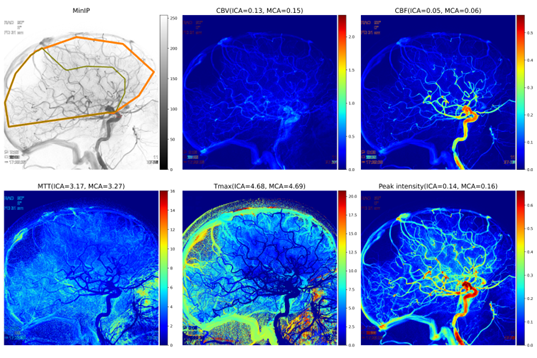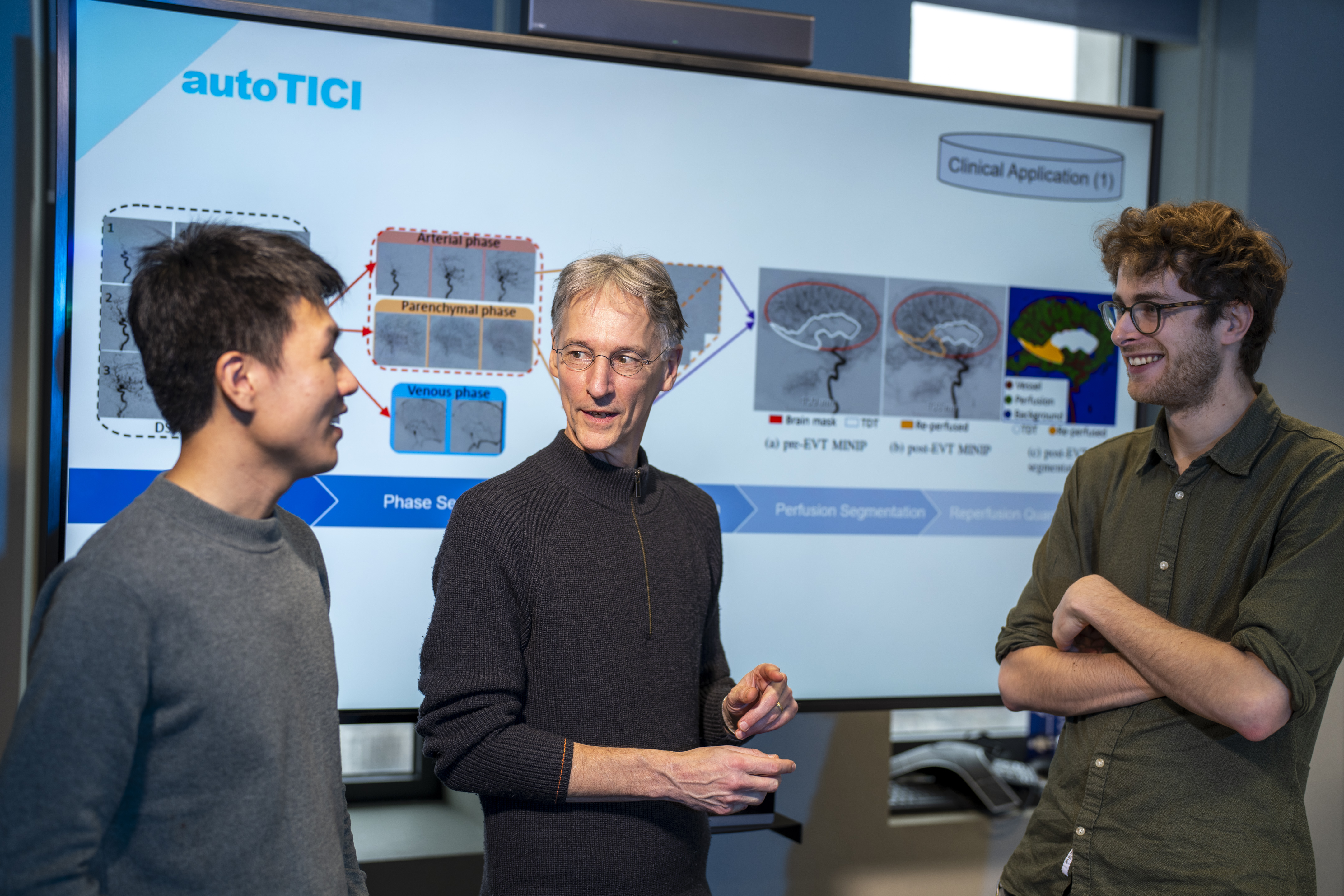About the research topic

This project aims to develop methods to quantify microvascular perfusion in Digital Subtraction Angiography (DSA) images during endovascular treatment. In our approach, the replacement of the recanalization concept with a measure of microvascular reperfusion is a major innovation. In the project, we developed and evaluated methods to quantitatively assess reperfusion in EVT procedures, both in the automated traditional way (autoTICI) and using novel quantitative DSA perfusion techniques. We demonstrated that autoTICI strongly correlates to the manual scoring, and can also replace manual scoring in outcome prediction models. In addition, preliminary studies in data acquired in the MR Clean trials suggest that there are perfusion parameters that may discriminate patients with good and bad outcome, in case the recanalization was scored as good. The project results may help clinicians to select patients for additional pharmacological treatment in case of insufficient reperfusion after treatment. This may lead to improved patient outcome in stroke treatment. Per-procedural (in the angiosuite) identification of the absence of reperfusion of brain tissue by DSA image analysis is therefore of great importance for the patient and society. As a first step, we are currently assessing the autoTICI scoring system in the Erasmus MC. Addtionally, various technical methods for DSA image analysis have been developed, including motion correction (i.e., AngioMoCo), artery-vein segmentation (i.e., CAVE), and spatio-temporal learning for perfusion detection.

Funding: Health Holland, Philips
Output
-
autoTICI: Automatic Brain Tissue Reperfusion Scoring on 2D DSA Images of Acute Ischemic Stroke Patients Ruisheng Su, Sandra A. P. Cornelissen, Matthijs van der Sluijs, Adriaan C. G. M. van Es, Wim H. van Zwam, Diederik W. J. Dippel, Geert Lycklama, Pieter Jan van Doormaal, Wiro J. Niessen, Aad van der Lugt, and Theo van Walsum, IEEE transactions on medical imaging 40, no. 9 (2021): 2380-2391.
-
Spatio-temporal deep learning for automatic detection of intracranial vessel perforation in digital subtraction angiography during endovascular thrombectomy Ruisheng Su, Matthijs van der Sluijs, Sandra A. P. Cornelissen, Geert Lycklama, Jeannette Hofmeijer, Charles B.L.M. Majoie, Pieter Jan van Doormaal, Adriaan C. G. M. van Es, Danny Ruijters, Wiro J. Niessen, Aad van der Lugt, and Theo van Walsum, Medical Image Analysis 77 (2022): 102377. Code
-
Automatic artery/vein classification in 2D-DSA images of stroke patients Vivian Van Asperen, Josefien Van Den Berg, Fleur Lycklama, Victoria Marting, Sandra Cornelissen, Wim Van Zwam, Jeanette Hofmeijer, Aad Van Der Lugt, Theo Van Walsum, Matthijs Van Der Sluijs, Ruisheng Su, Medical Imaging 2022: Image-Guided Procedures, Robotic Interventions, and Modeling, vol. 12034, pp. 366-377. SPIE, 2022.
-
Safety and efficacy of periprocedural antithrombotics in patients with successful reperfusion after endovascular stroke treatment Wouter van der Steen, P Matthijs van der Sluijs, Rob A van de Graaf, Ruisheng Su, Lennard Wolff, Henk van Voorst, Heleen M den Hertog, Pieter Jan van Doormaal, Adriaan C G M van Es, Julie Staals, Wim van Zwam, Hester F Lingsma, René van den Berg, Charles B L M Majoie, Aad van der Lugt, Diederik W J Dippel, Bob Roozenbeek, Journal of Stroke and Cerebrovascular Diseases 31, no. 10 (2022): 106726.
-
Towards quantitative digital subtraction perfusion angiography: An animal study Ruisheng Su, P Matthijs van der Sluijs, Joaquim Bobi, Aladdin Taha, Heleen M M van Beusekom, Aad van der Lugt, Wiro J Niessen, Danny Ruijters, and Theo van Walsum, Medical Physics 50, no. 7 (2023): 4055-4066. Code
-
AngioMoCo: learning-based motion correction in digital subtraction angiography Ruisheng Su, Matthijs van der Sluijs, Sandra Cornelissen, Wim van Zwam, Aad van Der Lugt, Wiro J Niessan, Danny Ruijters, Theo van Walsum, and Adrian Dalca, International Conference on Medical Image Computing and Computer-Assisted Intervention, pp. 770-780. Cham: Springer Nature Switzerland, 2023. Code
-
Automated image registration of cerebral digital subtraction angiography Vincent J W Hellebrekers, Theo van Walsum, Ihor Smal, Sandra A P Cornelissen, Wim H van Zwam, Aad van der Lugt, Matthijs van der Sluijs, and Ruisheng Su, International Journal of Computer Assisted Radiology and Surgery 19, no. 1 (2024): 147-150.
-
Clinical consequence of vessel perforations during endovascular treatment of acute ischemic stroke Matthijs van der Sluijs, Ruisheng Su, Sandra Adriana Cornelissen, Adriaan CGM van Es, Geert J Lycklama a Nijeholt, Bob Roozenbeek, Pieter-Jan van Doormaal, Jeannette Hofmeijer, Aad van der Lugt, Theo van Walsum, MR CLEAN Registry investigators, Neuroradiology 66, no. 2 (2024): 237-247.
-
CAVE: Cerebral artery-vein segmentation in digital subtraction angiography Ruisheng Su, Matthijs van der Sluijs, Yuan Chen, Sandra Cornelissen, Ruben van den Broek, Wim van Zwam, Aad van Der Lugt, Wiro J Niessen, Danny Ruijters, and Theo van Walsum, Computerized Medical Imaging and Graphics 115 (2024): 102392. Code
-
Multimodal deep learning for functional outcome prediction in EVT Frank te Nijenhuis, Ruisheng Su, Peter Jan van Doormaal, Jeannette Hofmeijer, Jasper Martens, Wim van Zwam, Aad van der Lugt, Xucong Zhang, and Theo van Walsum, SWITCH Workshop 2024.


